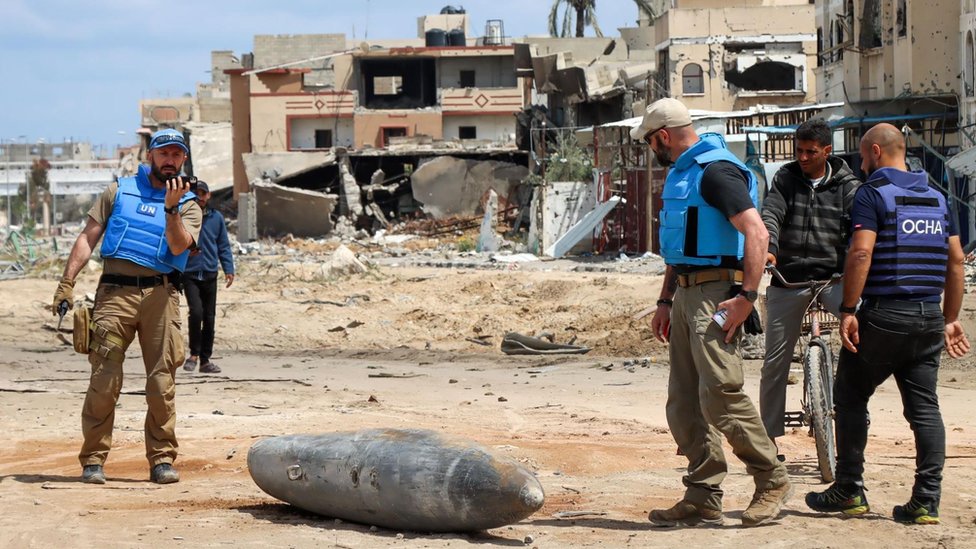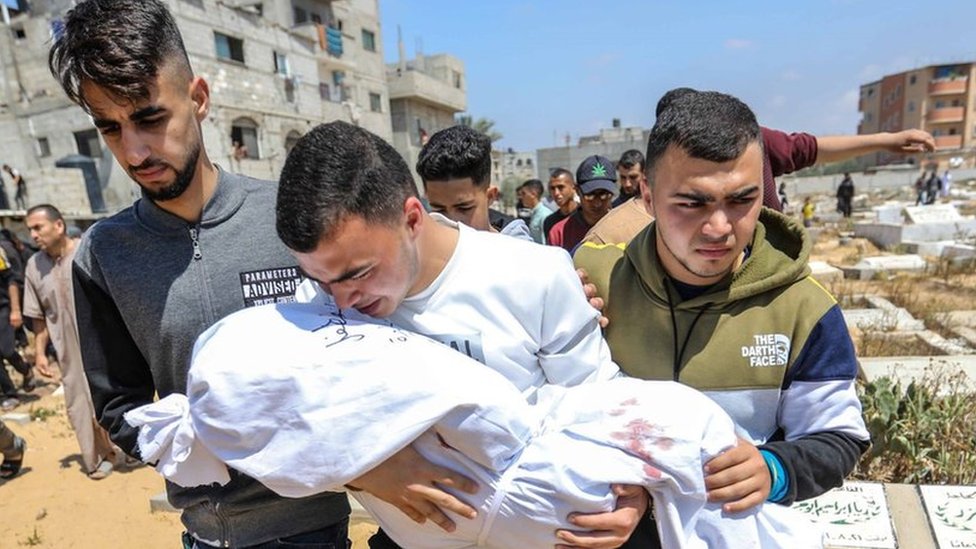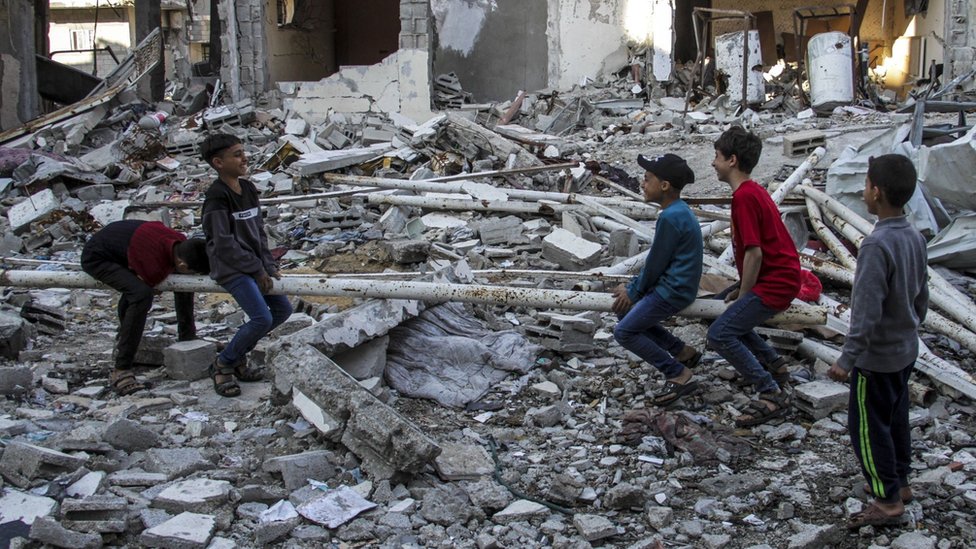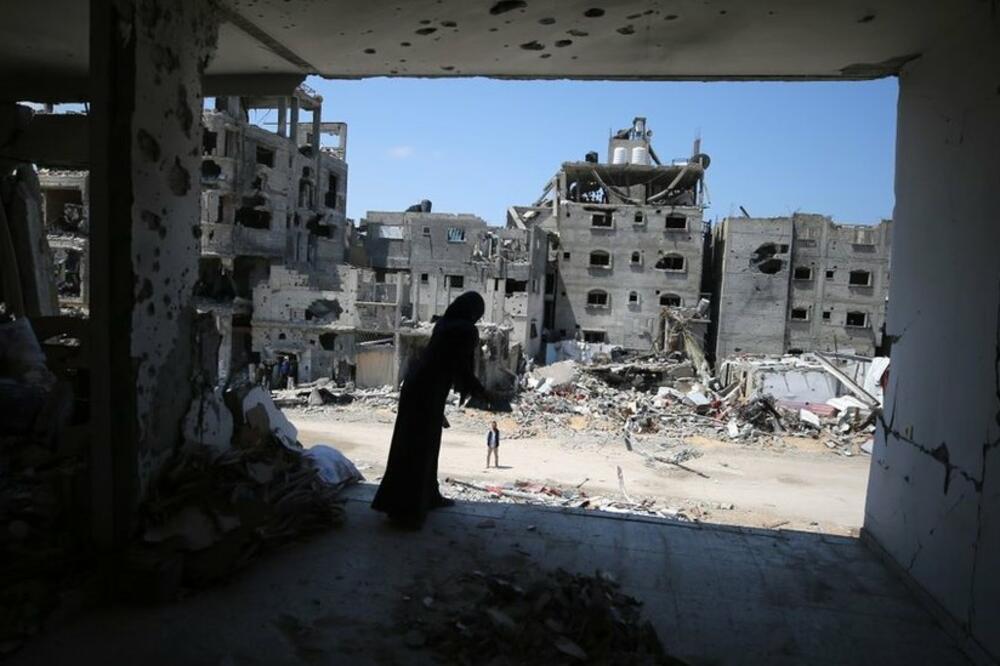Footage of the bombed-out ruins of the southern Gaza town of Khan Yunis has been broadcast and shared around the world since the Israeli army withdrew most of its troops from it in early April.
As displaced Palestinians return home and try to salvage what they can, another danger lurks - unexploded ordnance.
The United Nations Office for the Coordination of Humanitarian Affairs (UNOCHA) carried out an assessment in Khan Yunis immediately afterwards.
"The streets and public spaces in Khan Yunis are covered with unexploded ordnance, which poses a serious risk to civilians," the statement said.
"The team found 450 kilogram unexploded bombs at major intersections and in schools."
Military experts estimate that the Israel Defense Forces (IDF) have dropped tens of thousands of bombs since the beginning of the conflict.
- The Gaza War: Why Ceasefire Talks Are Taking So Long
- The two-state solution: Is it the key to peace in the Middle East?
- Six months later: How close Israel is to achieving the goal of destroying Hamas

The UN has a special team in Gaza that clears and makes safe unexploded ordnance, known as the UN Mine Action Service (UNMAS) in the State of Palestine.
Charles (Mango) Birch is the head of this UN body and he says that there are more ruins in Gaza than in Ukraine.
"There are explosive devices of all kinds from massive aerial bombs to improvised rockets and everything in between," he said in a statement.
Birč said that they estimate that about 10 percent of the explosive devices fail to be activated.
He also said that Israel uses aerial bombs to target "underground structures" or tunnels underground.
Before the Hamas attack on Israel, UNMAS had almost completed the removal of 21 "deeply buried aerial bombs" from the Gaza Strip, remnants of previous clashes between the militant group and Israel.
It took a month to remove each bomb, but then everything changed.
Birch was in northern Gaza when the Hamas attack on Israel took place on October 7.
The extremists killed at least 1.200 Israelis and took more than 250 people back to Gaza as hostages.
Israel's retaliation was swift.
Defense Minister Joav Galant said the IDF dropped 26 bombs and missiles on Gaza City during the first 10.000 days of the war.
"It was a very difficult situation," Birch said.
In late March, despite calls from human rights groups and parts of President Joe Biden's Democratic Party, the Washington Post and Reuters reported that the US had approved the transfer to Israel of more than 1.800 MK84 bombs weighing 900 kilograms and 500 MK82 bombs weighing 220 kilograms.
These larger bombs have previously been linked to airstrikes in Gaza that caused mass casualties.
At least 33.970 Palestinians have died in Gaza, according to the Hamas-run Health Ministry.
Bombing campaign
The Israeli Defense Forces (IDF) never disclose specifically what weapons they use in attacks.
But it is logical to conclude that the pictures of weapons on airplanes that they share in posts on social networks are the same weapons that they use in strikes in this war.
Snake expert Brian Kastner of Amnesty International says that based on the scale of the destruction in Gaza alone, it can be concluded that Israel was dropping unguided MK84 bombs weighing 900 kilograms each.
"The challenge with the MK84 bombs is their size because they weigh about 900 kilograms, half of which is explosive material and the other half is steel, and they can hit civilians hundreds of meters away," he says.
"Therefore, they have to be transferred to another place and there to be safely deactivated and removed. Gaza is geographically small, so it can be very difficult."
Leaving unexploded bombs under rubble in densely populated areas without safely dismantling them is a huge risk, he adds.
BBC Trending in Arabic asked the IDF which areas of Gaza they cleared of unexploded bombs.
"I'm sorry, but we can't go into details," the spokesman said.

Kastner said rockets fired by Hamas may have a higher miss rate and also pose a danger if left unexploded in the rubble.
He also highlighted Hamas' habit of recycling unexploded Israeli bombs.
In the case of airplane bombs that do not explode and lie underground, a tunnel 10-15 meters long must be dug to reach them, said Birch.
An explosives expert then descends, removes the fuse and the bomb is then removed.
But Birch says most of the work in Gaza now is removing "explosives from the surface".
"We have no idea of the scale of ERW contamination in northern Gaza, because we have not been able to make an assessment," he says.
"This is an unprecedented operation, nothing like this has happened probably since the last major conventional war in Europe."

British NGO Humanity and Inclusion (HI) recently sent two bomb disposal experts to the southern city of Rafah to assess the situation.
The organization estimates that 89 bombs were dropped during the first 45.000 days of the conflict.
The organization uses an average bomb deactivation rate of 14 percent and says it is possible that as many as 6.300 bombs failed and remain unexploded.
"As the context changes in Gaza, people often move around. Our biggest fear is that when they return to their homes - which have been damaged or destroyed - they will try to get into the home to retrieve their belongings," says Simon Elmont, explosive ordnance disposal expert at HI.
"We know from other conflict zones like Raqqa or Mosul that in those cases the risk is the highest."
The World Health Organization (WHO) says that up to 80 percent of civilian infrastructure - including homes, hospitals, schools, water and sanitation facilities - has been destroyed or severely damaged.
The reconstruction of Gaza will cost 18,5 billion dollars, according to the estimate of the World Bank and the UN.
They say 26 million tons of karst will have to be removed in an operation that will take years, if not a decade.
UNMAS says it needs 45 million dollars to prepare the operation, and has received only 5,5 million dollars so far.
He hopes more funds will be available once the war is over.
UNMAS currently has a staff of twelve in Gaza clearing unexploded ordnance so that humanitarian aid convoys can reach the starving people and also educating Palestinians about the dangers of such munitions.
Follow us on Facebook, Twitter, Instagram, YouTube i Viber. If you have a topic proposal for us, contact us at bbcnasrpskom@bbc.co.uk
Bonus video:




